经皮椎体后凸成形术后复发性脊柱硬膜下血肿:一份独特的病例报告。
IF 1.9
4区 医学
Q2 ORTHOPEDICS
引用次数: 0
摘要
经皮椎体后凸成形术后出现脊髓硬膜内(硬膜下和蛛网膜下腔)血肿是一种极为罕见的并发症。在本报告中,我们描述了一例椎体后凸成形术后发生两次蛛网膜下腔出血并伴有延迟性瘫痪的病例。一名 73 岁的男性因 T12 水平骨质疏松性脊椎骨折在我院接受了经皮椎体后凸成形术。在接受椎体后凸成形术治疗 T12 骨质疏松性脊椎骨折 55 小时后,他出现了下肢瘫痪。医生紧急为他进行了从 T8 到 L2 的后路减压术。并清除了蛛网膜下血肿。术后,神经症状迅速好转。然而,术后两周,患者出现了严重的神经功能衰退(截瘫,伴有感觉和自主神经功能障碍)。医生紧急实施了从 T5 到 L2 的后路减压术。蛛网膜下血肿被清除。该病例反映了脊髓硬膜下血肿的病因和进展。以往的文献对脊髓蛛网膜下腔出血的最佳治疗方法存在争议,但患者的预后在很大程度上取决于精确的症状评估和定位。本文章由计算机程序翻译,如有差异,请以英文原文为准。
Recurrent spinal subdural hematoma following percutaneous kyphoplasty: A unique case report
Spinal intradural (subdural and subarachnoid) hematoma following percutaneous kyphoplasty is an extremely rare complication. In this report, we described a case of 2 episodes of subarachnoid hemorrhage with delayed paralysis after kyphoplasty. A 73-year-old man underwent percutaneous kyphoplasty in our hospital an osteoporotic vertebral fracture at the T12 level. On the 55 h after kyphoplasty for T12 osteoporotic vertebral fracture, he developed paralysis of the lower limbs. An emergency posterior decompression from T8 to L2 was performed. And the subarachnoid hematomas were removed. Postoperatively, the neurological symptoms improved rapidly. However, 2 weeks after the operation, the patient experienced a setback with severe neurological decline (paraplegia with sensory and autonomic dysfunction). An emergency posterior decompression from T5 to L2 was performed. The subarachnoid hematomas were removed. This case reflects the cause and progression of spinal subdural hematoma. Previous literature has debated the best treatment approach for spinal subarachnoid hemorrhage, but the prognosis of patients is heavily dependent on precise symptom evaluation and localization.
求助全文
通过发布文献求助,成功后即可免费获取论文全文。
去求助
来源期刊

Chinese Journal of Traumatology
ORTHOPEDICS-
CiteScore
3.80
自引率
4.80%
发文量
1707
审稿时长
28 weeks
期刊介绍:
Chinese Journal of Traumatology (CJT, ISSN 1008-1275) was launched in 1998 and is a peer-reviewed English journal authorized by Chinese Association of Trauma, Chinese Medical Association. It is multidisciplinary and designed to provide the most current and relevant information for both the clinical and basic research in the field of traumatic medicine. CJT primarily publishes expert forums, original papers, case reports and so on. Topics cover trauma system and management, surgical procedures, acute care, rehabilitation, post-traumatic complications, translational medicine, traffic medicine and other related areas. The journal especially emphasizes clinical application, technique, surgical video, guideline, recommendations for more effective surgical approaches.
 求助内容:
求助内容: 应助结果提醒方式:
应助结果提醒方式:


